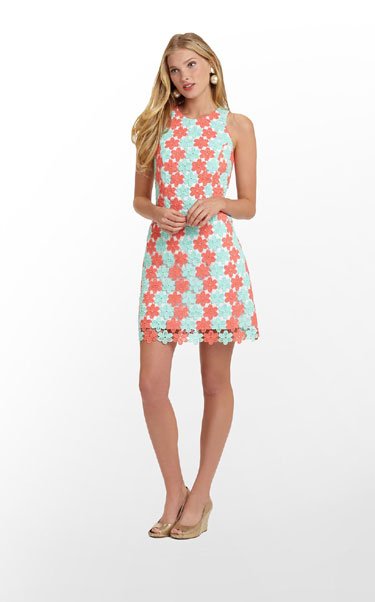Megan Garber collects criticisms of the Lilly Pulitzer clothing line and then opens up on it herself, sounding rather like (a more clever) Tom Buchanan denouncing Jay Gatsby, for “selling what cannot, in fact, be bought.”
I’d, of course, never even heard of Lilly Pulitzer, and I have some difficulty perceiving a connection between all those vivid pastels and what Mr. Burke used to refer to as “the unbought grace of life,” but reading this piece in the Atlantic I could not help but think, that if these women’s duds succeed in upsetting lefties so much, Lilly Pulitzer must be doing something right.
In January, the clothing-and-lifestyle brand Lilly Pulitzer announced that it would collaborate with Target, releasing a collection of 250 pieces of apparel, accessories, and home decor by way of the discount chain. This weekend, the results of that collaboration were put up for sale in Target stores and on its website. Both of these events would seem to be innocuous: yet another instance of the discount retailer’s collaboration with a high-end fashion brand, of luxury goods made accessible to the masses, of fashion (relatively) democratized. A win-win! Actually, a win-win-win!
There was something different, however, about this particular launch. #LillyforTarget ended up, remarkably … angering people. Lots of people.
The collaboration angered, first of all, fans of Lilly Pulitzer, whose clothes have doubled as a “preppy uniform†for decades. It angered Target customers who tried, and failed, to grab $40-ish “Lillys†during a sale that was meant to span several weeks and instead spanned mere hours. It angered Target executives, who were disappointed in the performance of the chain’s website during the sale and indignant that the products they’d intended for their customers were being resold on eBay for more than twice the original cost.
Most interestingly, though, #LillyforTarget provoked the vitriol of fashion critics and business-minded brand-watchers. “I have never seen a woman wearing Lilly Pulitzer who would not have looked better in a ratty flannel bathrobe,†the business writer Megan McArdle confessed. The fashion critic Robin Givhan noted that “the classic Lilly Pulitzer dress comes in shrill shades of yellow and pink that are vaguely infantilizing. They are clothes that can be shrunk down and worn by 7-year-old girls without changing a single design element—if there were actual design elements to change. But there are not. …
[I]n part, it’s the aesthetics of Pulitzer’s clothes. Which are, with their festively flora-fauna-ed prints, the sartorial equivalents of the people who can’t stop talking about the juice cleanse they’re on. They are perky, insistently so. They are self-absorbed, aggressively so. Your retinas aren’t currently up for seeing some bubble-gum-pink toucans, their bills interlocked in an explosion of avian paisley? Lilly Pulitzer does not care. Lilly Pulitzer does not even think to ask.
The broader criticism, though, is the performance of identity that the Pulitzer brand represents. “Lilly†is not about luxury; it is about privilege. There is an important distinction between the two, Givhan notes. The brand, she writes, “suggests an advantage of birth. The clothes stir up scrapbook notions of ancient family trees, summer compounds, boarding school uniforms, and large, granite buildings inscribed with some great-great-grandfather’s name. Lilly Pulitzer represents something that money cannot buy.â€
Which is another way of saying that Pulitzer’s clothes evoke not just wealth, but class. They speak to a status that is conferred rather than earned, and that cannot—with apologies to hard work and good luck and all the other vehicles of the American dream—be fully democratized. The garments are evidence in that sense not (just) of conspicuous consumption, but rather of privilege as it plays out as an economic system. They nod to, and then politely ignore, Thomas Piketty. Those whimsy-dripping pineapples, those insouciant peacocks, the designs that are often described as “eye-poppingâ€â€”they are evidence not just of “resortwear†gone mainstream, but also of the ease of living enjoyed by those who can use the term “resortwear†unironically. These are clothes that are worn by people for whom life is, in relative terms, a permanent vacation.
Read the whole thing… and marvel.

Typical Lilly Pulitzer patterns.






Karen Myers (the wife)
If they were old enough, they’d have loved Emilio Pucci — his version of resort wear with a flair.
Why don’t we hear them complaining about preppie sportswear like J Crew or LL Bean?
I guess it’s all about “me, me, me” (special funky-dressing special snowflake) vs “they” (people with taste), as if dressing like a special snowflake isn’t just a tribe of its own, like goth, or hippie.
Mark Matis
Yet they have NO problem effusing enthusiastically about the attire of the Mad Cow – Angus Breed.
bob sykes
Reminds me of William Morris designs, he being the well-known (once) 19th Century English socialist.
The effect is enhanced by the model, young, blond, beautiful, WASPy.
Buttercup
I think they pile on Lilly P. because her designs are a lot more distinctive than J Crew or LL Bean. I’d actually be more inclined to purchase a Lilly dress than a J Crew because for that kind of pricey, I’d want something a little more unique than what J Crew or LL Bean offer.
What was most funny to me about the excerpt quoted above is the author likens Lilly to children’s styles. Around here (Florida) the older ladies seem to dig her the most. So, I associate the brand with resort wear for the retired ladies. Not that I have anything against pretty bright prints or Lilly in general!
gonewiththewind
I’m just a simple man and fail to understand how either the pattern of the material or the style of the clothing mean a whole lot. The picture is a beautiful young lady who would look good in nothing. If she was wearing the latest Walmart cheap clothing she would look good. I barely noticed what she was wearing. If she had been over weight or unattractive she could be wearing $10,000 outfits and I wouldn’t even see her if I walked past her in the street. Simple as that.
Maggie's Farm
Saturday morning links
Top Ten Most Expensive Prescription Drugs Hating Lilly Pulitzer I like that Lilly stuff. They even make stuff for men, but you have to be above-average macho to wear it. Ways to Improve Your Mental Health How about a ‘Capitalism Day’ to balance ‘
buttercup
GTW: Dressing for men is actually quite simple. As your remarks make plain. Women dress, mostly, for other women.
Also, there’s signaling from the girl in the picture that by not wearing the latest Walmart couture she is not interested in the males who fall into a similar Walmart economic class.
ama
Long ago I heard the story that Lilly Pulitzer started her clothing line after her husband divorced her; she wanted to make sure she could provide for herself and her children. I take it with a grain of salt since it was anecdotal and a story just a few lines longer than what I’ve relayed here. I think its great that she marketed to people she knew, plus she knew they had money to buy her product- win-win! Do “I” want neon crayon colored clothing? none of your business…
the gold digger
I wish I could get paid to write about the inconsequential things that I hate.
Larry, first of his name...
“The Wife” is right to ask ‘why pick on Lilly Pulitzer?’
I remember, not long ago, reading an article praising J. Crew for it’s sartorial sense and business practices. You see, they get exclusives from small manufacturers, the sort of designers that Lefties most admire.
But I think the distinction between the absence of criticism, and indeed downright praise of J. Crew vice Lilly Pulitzer, is that those making the loudest critique actually shop at J. Crew. The critics would never dream of buying something as declasse as something bright from Target. For the left Lilly Pulitzer is the intersection of “those we hate/envy & those we would never want to be like.”
Of course, it’s all an illusion. The quest for an individual style is the hallmark of a self obsessed middle schooler. Funny to read how the author places such importance on it.
gonewiththewind
Buttercup: Your points are correct. I do somewhat disagree with the old line that women dress to impress other women and not men, but never the less you are correct. I also think I am correct that men just don’t care. I could not tell you where a dress was sold or how much it costs but I can assure you I can see a pretty girl in a crowd, in a dark bar, in nice clothes or old clothes, etc. It is like male radar and I have found over the years that women also see a good looking man without regard to cothes. It would be female radar.
Windows Server Lisans
Yes! Finwlly something ablut Windows Lisans.
sa?l?k personeli al?m?
Very descriptive post, I enjoyed that bit. Will tere be a part
2?
JDZ
I don’t think so.
Please Leave a Comment!